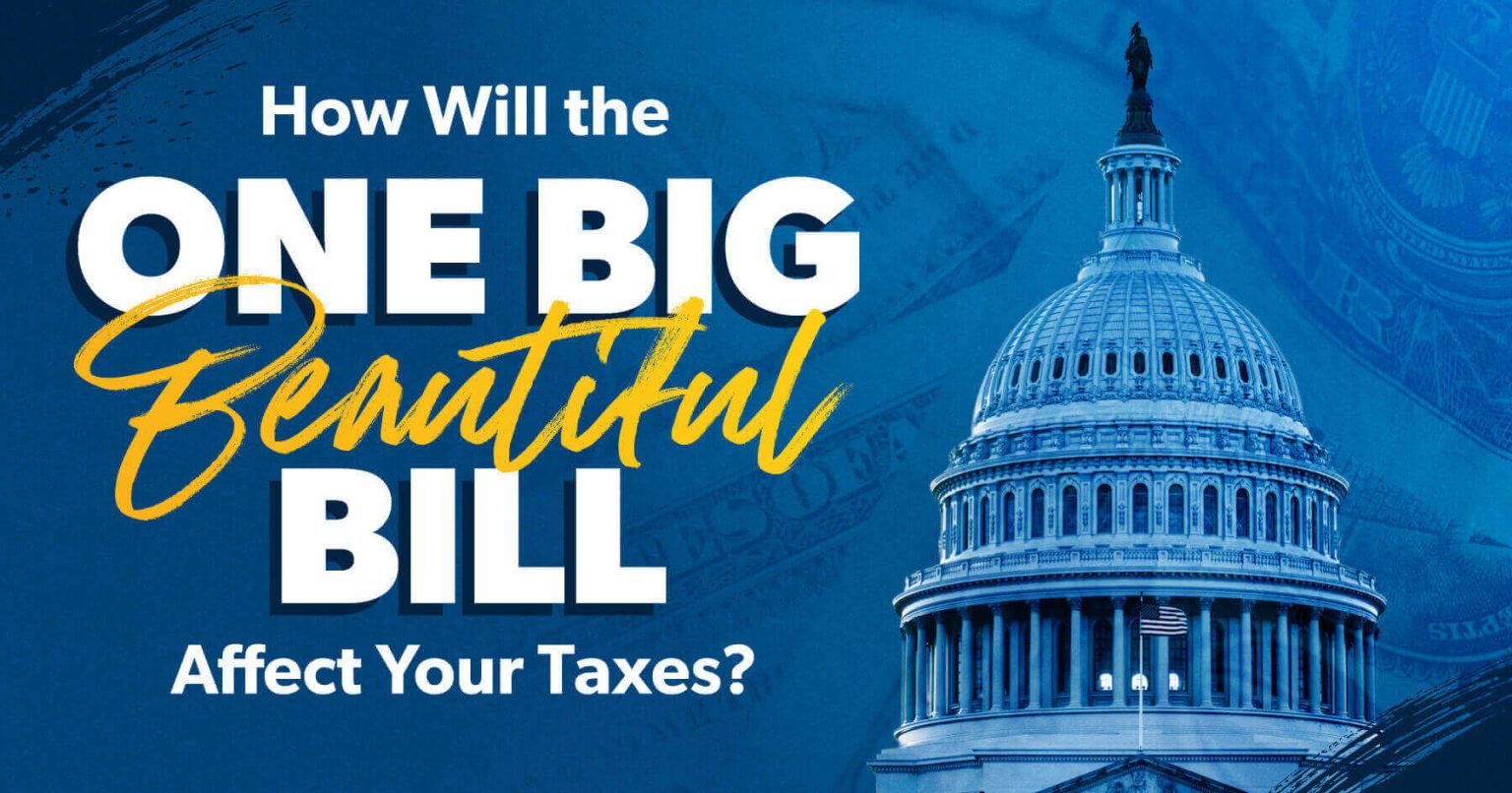Back in 2017, Congress delivered a massive tax overhaul for Americans, cutting tax rates, doubling the standard deduction, capping certain deductions, and simplifying the tax code for millions of families.
But they slapped an expiration date on most of those changes—and those changes were finally set to expire at the end of 2025 . . . unless Congress acted.
And so, after a lot of negotiating and back-and-forth between Capitol Hill and the White House, Congress passed the One Big Beautiful Bill Act (OBBBA), which locks in many of those rules for good, and it was signed into law by President Trump July 4, 2025.
This new law doesn’t just keep the status quo in place, though. Like the name suggests, it is a big bill that not only keeps things the same but also adds plenty of new wrinkles to the tax system.
What Is the One Big Beautiful Bill Act?
In short, the One Big Beautiful Bill Act (OBBBA) is a massive piece of tax legislation (it’s 870 pages long) that makes permanent many of the changes that were first introduced by the 2017 Tax Cuts and Jobs Act (TCJA). And while it’s mostly a tax-focused law, it does touch on several areas that go way beyond taxes.1
The bill also increases government spending for things like border security and defense, adds work requirements for able-bodied adults on Medicaid, and creates newborn investment accounts (called Trump accounts) that will automatically invest $1,000 at birth for all U.S. children born from 2025 through the end of 2028.
And that’s just scratching the surface. When the dust settles, the Congressional Budget Office (CBO) says the bill will add more than $3 trillion to the national debt through 2034.2
But for now, let’s take a deeper dive into how this new law will affect how you will file your taxes for 2025 and beyond.
What Does This Bill Mean for Your Tax Bill?
No matter what your filing status is or what tax bracket you find yourself in, you will feel the effects of this bill when you sit down to file your taxes in the spring of 2026.
While plenty is staying the same, there are several new tax deductions and some of them—the ones for seniors, car loan interest, tips and overtime—can be claimed even if you take the standard deduction.
There’s even a tax break carved out for . . . let us double-check our notes here . . . whaling captains and fishers living in Alaska (if you’re a whaling captain in Connecticut, we’re sorry—you’re out of luck).
Let’s dive into all of it.
1. The existing tax brackets and rates pretty much stay the same.
The government uses something called a progressive income tax system, which basically means the more you earn, the more you’ll gradually pay. There are seven tax brackets, and each tax bracket has a specific tax rate attached to it, ranging from 10% to 37%.
If you’re in the 24% tax bracket, for example, that doesn’t mean all your income will be taxed at 24%. Instead, some of your income will be taxed at 10%, the next portion will be taxed at 12%, and then whatever’s left will be taxed at 24% (that’s why it’s called progressive).
The tax rates and tax brackets that exist now were passed by Republicans as part of the 2017 tax reform law. Those rates were set to expire at the end of 2025 and would have raised taxes on nearly all Americans.
But this bill makes those lower rates permanent, while at the same time slightly expanding the lowest two tax brackets, providing a small boost for lower-income taxpayers.
So, let’s get right to it! (By the way, unless we say otherwise, everything we’re about to cover comes directly from the new law itself.3)
2. The increased standard deduction is made permanent and increases.
The standard deduction automatically reduces your taxable income by a set amount based on your tax filing status. Think of it as the “easy button” of tax savings, and the 2017 tax reform law doubled the standard deduction, making it an even more appealing option for more taxpayers.
The One Big Beautiful Bill Act permanently extends the larger standard deduction and even adds another $750 ($1,500 for couples) to the deduction. Starting in 2025, the standard deduction will be $31,500 for married couples filing jointly, $23,625 for heads of household, and $15,750 for single filers. And yes, the standard deduction will continue to be adjusted for inflation each year.
The bill also permanently eliminates various deductions available to those who itemize their tax returns. More on that later.
3. Seniors get a new tax deduction from 2025 to 2028.
Does the new megabill deliver on Trump’s campaign promise of “no tax on Social Security benefits”? Not exactly. What it does do is give seniors a temporary tax deduction of $6,000 from 2025 through 2028. And to sweeten the deal, this tax break is available whether you take the standard deduction or itemize.
But it’s not all good news. The deduction begins to phase out for seniors who earn more than $75,000 a year ($150,000 for couples), so you might have to settle for a reduced deduction.
4. The SALT deduction gets a huge bump.
New Yorkers and Californians (and citizens of other high-tax states), rejoice! The state and local tax (SALT) deduction just got even more salty. The bill raises the cap on the amount of state and local taxes, which also includes property taxes, that you can write off your tax return to $40,000 (up from $10,000).
A couple other things to note: The deduction is reduced for those making over $500,000 per year, and the deduction becomes $10,000 again if your income is $600,000 or more. This is also a temporary deduction, with the cap set to return to the $10,000 mark starting in 2030.
5. No taxes on tips or overtime pay (for the most part).
If you’re a tipped worker, you’ll be able to keep more of that dough for yourself. From 2025 through 2028, you’ll be able to write off up to $25,000 of tips from your income. The deduction starts to phase out for anyone making more than $150,000 per year ($300,000 for couples). A Social Security number is needed to claim this deduction.
Don’t worry overtime workers, lawmakers didn’t forget about you! The bill adds a tax deduction of up to $12,500 ($25,000 for couples) for overtime wages from 2025 through 2028. And just like with tipped workers, the deduction phases out for those making more than $150,000 per year.
But it’s important to read the fine print on this one: This tax cut for overtime pay is mostly available to hourly—not salaried—workers, and a Social Security number is required in order to claim it.
6. More people can claim charitable deductions on their tax returns.
We always say that giving is the most fun thing you can do with your money. And now, everyone can enjoy a tax break for their charitable giving—even if you normally take the standard deduction. (Before the bill, you had to itemize in order to deduct donations on your tax return.)
Starting in 2026, you can write off up to $1,000 of your charitable donations ($2,000 for couples)—so make sure you keep track of all the giving you do throughout the year! But if you’re a higher-income individual, you’ll have to donate more to qualify for the deduction.
7. The child tax credit gets extended and increases.
The child tax credit was scheduled to move back to $1,000 per child at the end of this year, but instead, the bill permanently extends (and adds to) the child tax credit. The child tax credit will be $2,200 per child by 2026. The credit will also be adjusted for inflation each year.
The bill adds one new restriction for this credit: At least one parent has to have a Social Security number in order to claim it (currently, only the child needs one).
8. The adoption tax credit becomes partially refundable.
If you’re planning to adopt a child, this one is exciting: The new legislation makes the adoption tax credit partially refundable up to $5,000 starting in 2025 (and it will be indexed for inflation). That means if you owe taxes, this tax credit will reduce your tax bill dollar for dollar—and any remaining amount will be paid back to you as a refund.
Under the old law, the credit was not refundable, but if you had any unused credit it could be carried forward for up to five years. Now? The refundable portion of the credit cannot be carried forward.
9. Car loan interest on U.S.-made vehicles is now deductible.
If you buy a car in the next four years, you could deduct up to $10,000 each year in interest paid on auto loans. However, if you earn more than $100,000 a year ($200,000 for couples), that deduction begins to phase out.
There are a few important strings attached, though. First, the car must be brand-spanking-new, which means it’ll likely be more expensive to buy than any used car. Second, the car has to go through final assembly right here in the United States (think Ford and General Motors). This limits the kind of car that will qualify for this deduction.
But listen, we’re just going to come out and say it: Unless you have a net worth of at least $1 million, buying a new car is a bad idea—they immediately begin to drop in value the moment you drive it out of the dealership. And taking out a car loan to buy any car is a terrible financial decision, even with the tax break.
You’re better off buying a reliable used car with cash on hand instead of tying up hundreds (or in some cases thousands) of dollars in car payments each month.
10. Tax breaks for clean energy home improvements and electric vehicles are going away.
The bill ends tax credits for rooftop solar, geothermal heat pumps and other energy-efficient home devices at the end of 2025. The bill also ends a $7,500 tax credit that has helped reduce the cost of electric vehicles after September 30 (Sorry, Elon).
11. The estate tax exemption gets raised.
Currently, estates worth less than $14 million are exempt from being taxed. That level was set to drop to $7 million next year . . . but not anymore. Now, the estate tax exemption has been permanently increased and gets bumped to $15 million—and that figure will be adjusted each year for inflation.
12. The business income tax deduction is now permanent.
Thanks to the 2017 tax reform law, most small businesses (sole proprietorships, LLCs, S corporations and partnerships) can deduct 20% of their business income on their tax returns. The bill makes that deduction permanent.
13. Many wealthy households won’t have to worry about the alternative minimum tax.
Back in 2017, a new rule spared a lot of higher-income households—maybe even yours—from having to pay the alternative minimum tax (AMT). That tax was designed to keep people from using too many credits and deductions to dodge paying their fair share in taxes.
Well, here’s the good news: That rule was set to expire this year, but the Big Beautiful Bill makes it permanent.
But heads up—thanks to some new tweaks in this new law, a few more households will get hit with the AMT compared to the 2017 version. So, while most folks will still avoid it, a slightly larger group will have to pay.
14. Bad news for some homeowners with mortgages.
The bill permanently caps the amount of mortgage debt you can deduct interest on at $750,000. Without this bill, the limit would’ve gone back up to $1.1 million and even applied to a second home. That’s gone for good.
And you can forget about deducting interest on a home equity loan—that’s out the window (unless the loan is used to buy, build or substantially improve your home that’s securing the loan), which makes borrowing against your home an even worse idea than it already was.
But here’s one small win: You can still deduct private mortgage insurance (PMI) premiums as if they were interest. So you have that going for you . . . which is nice.
15. It’s a mixed bag for those impacted by natural disasters.
Back in 2017, the Tax Cuts and Jobs Act limited the losses homeowners could write off to only those caused by a federally declared disaster—meaning you could no longer write off losses due to a random fire, storm, theft or accident.
That was set to expire this year—until now. This bill makes that limitation permanent. But there is one new addition: The new law says that some state-declared disasters will be eligible for a deduction too.
And here’s a bonus: Even if you don’t itemize, you can still claim this disaster-related tax break.
Read the full article here











